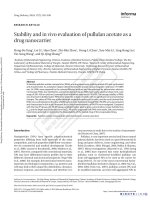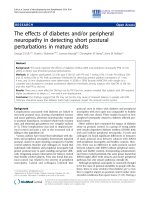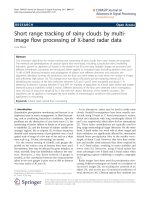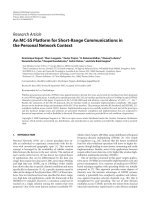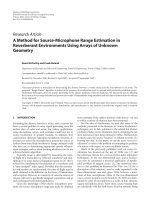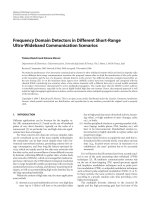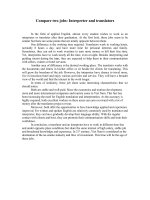Short range ferromagnetism in alloy ribbons of Fe Cr Si Nb (Ag, Cu)
Bạn đang xem bản rút gọn của tài liệu. Xem và tải ngay bản đầy đủ của tài liệu tại đây (1.03 MB, 6 trang )
Journal of the Korean Physical Society, Vol. 64, No. 7, April 2014, pp. 1016∼1021
Short-range Ferromagnetism in Alloy Ribbons of Fe-Cr-Si-Nb-(Ag, Cu)
P. Q. THANH, N. Q. HOA and N. CHAU
Faculty of Physics, Hanoi University of Science, Vietnam National University, Hanoi, Vietnam
C. X. HUU
Department of Electronics and Communication Engineering,
Danang University of Technology, Danang, Vietnam
D.-T. NGO
Department of Micro- and Nanotechnology, and Department of Energy and Storage,
Technical University of Denmark, Kgs. Lyngby 2800, Denmark
T. L. PHAN∗
Department of Physics, Chungbuk National University, Cheongju 361-763, Korea
(Received 19 December 2013, in final form 13 January 2014)
We have studied the magnetic properties of two amorphous alloy ribbons Fe72 Cr6 Si4 Nb5 B12 Ag1
(FCSNB-Ag) and Fe72 Cr6 Si4 Nb5 B12 Cu1 (FCSNB-Cu), prepared by using a melt-spinning technique. Magnetization (M ) measurements for various temperatures (T ) and magnetic fields (H)
indicate that ferromagnetic-paramagnetic (FM-PM) phase transitions take place in FCSNB-Ag and
FCSNB-Cu at Curie temperatures (TC ) of about 308.3 K and 322.5 K, respectively. Analyses of
M − H data at different temperatures in the vicinity of the FM-PM phase transition based on the
modified Arrott plot method and scaling hypothesis yielded the exponent values of β = 0.369 ±
0.005, γ = 1.359 ± 0.005 and δ = 4.7 ± 0.1 for FCSNB-Ag, and β = 0.376 ± 0.002, γ = 1.315
± 0.006 and δ = 4.5 ± 0.1 for FCSNB-Cu. Compared with the values from theoretical models,
these values are close to those expected for the 3D Heisenberg model, demonstrating the existence
of short-range FM order in the amorphous alloy ribbons.
PACS numbers: 75.20.En, 75.30.Cr, 75.40.-s
Keywords: Alloy ribbons, Critical behavior, Short-range magnetic order
DOI: 10.3938/jkps.64.1016
I. INTRODUCTION
Currently, Fe-, Ni- and Co-based amorphous alloys are
still an issue of intensive interest because of their promising applications in devices for conversion of electromagnetic energy into mechanic energy, magnetic refrigerator,
sensitive sensors, telecommunications, automotive magnetics, and electronic article surveillance [1–4]. Compared with the conventional alloys NiFe, FeCo and FeSi,
these amorphous alloys exhibit some rotable properties,
such as high corrosion resistance, relatively great saturation magnetization, and soft-magnetic behavior (i.e.,
small coercivity, leading to low hysteretic losses). Depending on the applications, these properties can be easily modified by changing the dimension and compositions
of the amorphous alloys. These amorphous alloys are
a promising new class of materials where applications
∗ E-mail:
; Fax: +82-43-275-6416
are in competition with those of the conventional alloys.
Particularly, the addition of Ti, Cr, Nb, Si, B and/or
Cu to Fe- and Co-metalloid alloys remarkably improves
their corrosion resistance and soft-magnetic behaviors
[2, 5–7]. Here, the combination of chemical elements
with different atomic radii stimulates structural disorder
(short-range structure) so that the amorphous phase can
be easily formed and ferromagnetic-paramagnetic (FMPM) phase-transition temperature (the Curie temperature, TC ) can be controlled.
Recently, more and more attention has focused on
fabricating and studying amorphous alloy ribbons for
magnetic-refrigeration technology, which is based on the
magnetocaloric (MC) effect [2, 3, 8–10]. This effect is
directly related to the temperature change (or magneticentropy change) under adiabatic conditions of a ferromagnet under an external applied field. The temperature (or magnetic-entropy) change is strongest around
the FM-PM phase-transition temperature TC , where
-1016-
Short-range Ferromagnetism in Alloy Ribbons· · · – P. Q. THANH et al.
magnetic moments become disordered due to the thermal activation energy [11]. For conventional applications in cooling systems (such as air conditioners, refrigeration and freezers), the TC of amorphous alloys
can be controlled in the temperature range of 260 ∼
310 K. For example, the TC values of the amorphous
alloy ribbons Fe78 Nb5 Si4 B12 Cu1 (> 450 K) [8, 9] and
Fe73.5 Nb3 Si13.5 B9 Au1 (> 600 K) [12] can be reduced
to lower temperatures by doping Cr into the Fe site.
Though many works have focused on the physical properties of Cr-doped Fe-Nb-Si-B-Cu-based amorphous alloy
ribbons [7–9,13], the magnetic interactions around their
FM-PM phase transitions have not been intensively studied. Additionally, no work in reference to the magnetic
properties of (Cr, Ag)-codoped Fe-Nb-Si-B alloy ribbons
seems to exist. To get more insight into these material systems, we prepared two amorphous alloy ribbons
Fe72 Cr6 Si4 Nb5 B12 Cu1 and Fe71 Cr7 Si4 Nb5 B12 Ag1 , and
then studied their magnetic properties based on magnetization (M ) versus temperature (T ) and magnetic field
(H) measurements. Based on the mean-field theory for
a second-order magnetic phase transition (SOMT) associated with long-range magnetic interactions [14], we
determined the values of the critical exponents β, γ
and δ associated with the temperature dependences of
the saturation magnetization, Ms (T ), the inverse initial
susceptibility, χ−1
0 (T ), and the critical isotherm M , respectively. Compared with the theoretical values, these
experimentally-determined values are close to those expected for the 3D Heisenberg model [15], demonstrating
the existence of short-range FM order in the amorphous
alloy ribbons.
II. EXPERIMENTAL DETAILS
Two amorphous ribbons (the widths and thicknesses
are of about 2-6 mm and 20 μm, respectively) with nominal compositions of Fe71 Cr7 Si4 Nb5 B12 Ag1 (FCSNB-Ag)
and Fe72 Cr6 Si4 Nb5 B12 Cu1 (FCSNB-Cu) were prepared
from high-purity elements (> 3N) as precursors by using
the melt-spinning technique. The fabrication was carried
out in a vacuum chamber at 10−4 Torr, and that pressure
was maintained by using an Ar gas flow. After preparation, the amorphous phase in the final ribbon products
was confirmed by using X-ray diffraction [9]. Magnetization versus temperature and magnetic field measurements were performed on a vibrating sample magnetometer (VSM), where the temperature and the magnetic field
could be changed from 100 to about 500 K and from 0
to 10 kOe, respectively. To study the critical behavior of
the alloy ribbons, we used Arrott plots [16, 17] and the
scaling hypothesis [15] to analyze the M − H − T data
in the vicinity of the TC .
-1017-
Fig. 1. (Color online) Temperature dependences of magnetization normalized to the value at 100 K, M /MT = 100
K, for the amorphous alloy ribbons in the field H = 100 Oe.
The inset shows dM /dT versus T curves.
III. RESULTS AND DISCUSSION
Figure 1 shows the temperature dependences of the
zero-field-cooled magnetization normalized to the value
at 100 K for the amorphous alloy ribbons FCSNB-Ag
and FCSNB-Cu in the field H = 100 Oe. The gradual
decrease in the magnetization at low temperatures can
be seen to become rapid when the temperature is higher
than 290 K, which is due to the FM-PM phase transition taking place at the TC . At temperatures above the
TC , the samples are in the PM state; thus, the magnetization decreases to zero. From the dM /dT versus T
curves, we obtained the TC values (from the minima of
the curves, as shown in the inset of Fig. 1) of FCSNB-Ag
and FCSNB-Cu to be about 309 K and 323 K, respectively. If more attention is given to the variation of the
M (T ) curves, that variation is quite different, particularly at temperatures above 150 K. While high M values
and a narrower FM-PM transition region are observed
for FCSNB-Cu, such features are absent from FCSNBAg. To explain the obtained results, we consider the Cr
content in the alloy ribbons because both Ag and Cu
in the same amounts are diamagnetic. The Cr content
in FCSNB-Ag (7 at.%) appears to be higher than that
in FCSNB-Cu (6 at.%). According to previous studies
[8, 9], the TC and M values of FCSNB-Ag should be
smaller than those of FCSNB-Cu. However, such scenarios do not occur in the present case. This proves that
the differences in the TC and M values, and in the characteristic phase transition not only depend on Cr-doping
content but also on the natures of the Ag and Cu elements present in the FCSNB host, where the Fe-related
FM phase plays an important role.
To further understand the magnetic properties of
FCSNB-Ag and FCSNB-Cu, we recorded magnetic-field
-1018-
Journal of the Korean Physical Society, Vol. 64, No. 7, April 2014
Fig. 2. (Color online) (a, b) M (H) curves and (c, d) Arrott plots of M 2 versus H/M for amorphous alloy ribbons
of FCSNB-Ag and FCSNB-Cu at temperatures around the
FM-PM phase transitions.
dependences of the initial magnetization, M (H), at different temperatures and then studied their critical behavior by determining the values of the exponents β, γ
and δ. As shown in Figs. 2(a) and (b), the magnetization gradually decreases, and the nonlinear M (H) curves
in the FM region tend to become linear with increasing
temperature because the samples go into the PM state.
Though the field is increased up to 10 kOe, no saturation magnetization occurs. This phenomenon was also
observed in Fe70 Cr8 Si4 Nb5 B12 Cu1 [8] and in other alloy
ribbons [4,18], which is a characteristic of ferromagnets
without true long-range magnetic order. According to
the mean-field theory (MFT) proposed for a ferromagnet exhibiting a SOMT and long-range magnetic interactions [14], the free energy GL can be expanded in even
powers of M as follows:
GL = aM 2 + bM 4 + . . . − HM,
(1)
where a and b are temperature-dependent parameters.
Minimizing GL gives the relation:
H/M = 2a + 4bM 2 .
(2)
This equation indicates that when the magnetic interactions in a ferromagnet obey the MFT, the plots of M 2
versus H/M around the TC are parallel straight lines.
Particularly, the M 2 versus H/M line at the TC passes
through the coordinate origin, as in Arrott plots [16,17].
However, these features are not observed in Figs. 2(c)
and (d), which means that magnetic interactions in our
amorphous alloys FCSNB-Ag and FCSNB-Cu do not
Fig. 3. (Color online) Modified Arrott plots with trial
exponents β = 0.365 and γ = 1.336 expected for the 3D
Heisenberg model.
have long-range order. More evidence supporting this
conclusion can be gotten from the critical exponents β,
γ and δ. Within the framework of the MFT, Eq. (2)
for modified Arrott plots (MAP) can be generalized by
using the scaling equation of state [17]
(H/M )1/γ = c1 ε + c2 M 1/β ,
(3)
where c1 and c2 are temperature-dependent parameters,
and ε = (T −TC )/TC is the reduced temperature. In this
equation, the β, γ and δ values can be obtained from the
asymptotic relations
Ms (T ) = M0 (−ε)β ,
γ
χ−1
0 (T ) = (h0 /M0 )ε ,
ε < 0,
ε > 0,
(4)
(5)
M = DH 1/δ ,
ε = 0,
(6)
where M0 , h0 , and D are the critical amplitudes. We
should notice that if β = 0.5 and γ = 1.0, Eq. (3) returns the form of Eq. (2). However, these β and γ values
are not suitable for describing magnetic interactions taking place in our alloys. Thus, more accurate values are
needed. In the present work, we have used the MAP
method, starting from the scaling equation of state with
trial exponent values of β = 0.365 and γ = 1.336 expected
for the 3D Heisenberg model [15]. As mentioned above,
correct β and γ values make the M (H) data falling on a
Short-range Ferromagnetism in Alloy Ribbons· · · – P. Q. THANH et al.
Fig. 4. (Color online) Ms (T ) and χ−1
0 (T ) data around
TC fitted to Eqs. (4) and (5), respectively, for (a) FCSNBAg and (b) FCSNB-Cu. The insets show the isotherms at
temperatures close to TC fitted to Eq. (6).
set of parallel straight lines in the performance of M 1/β
versus (H/M )1/γ , and the M 1/β versus (H/M )1/γ lines
pass through the origin at the TC . These features can
be clearly seen in Fig. 3 for magnetic fields H > 3 kOe,
proving that the values of the critical exponents associated with short-range magnetic interactions of the 3D
Heisenberg and/or 3D Ising models are more suitable for
describing our system.
With the trial exponent values and the MAP shown in
Fig. 3, Ms (T ) and χ0 (T ) data obtained from the linear
extrapolation in the high-field region (H > 3 kOe) to the
M 1/β and (1/χ0 )1/γ axes are then fitted to Eqs. (4) and
(5), respectively, to achieve better β, γ and TC values.
These new values of β, γ and TC are continuously used
for the next MAP processes until their optimal values
are achieved. Notably, during the best fitting process,
the TC values determined from the M (T ) data (shown
in Fig. 1) were used as a reference. The final results
are shown in Fig. 4 and Table 1, where the values of the
critical parameters are TC ≈ 308.3 K, β = 0.369 ± 0.005,
γ = 1.359 ± 0.005 and δ = 4.7 ± 0.1 for FCSNB-Ag and
TC ≈ 322.5 K, β = 0.376 ± 0.002, γ = 1.315 ± 0.006 and
δ = 4.5 ± 0.1 for FCSNB-Cu. The TC values obtained in
this case can be seen to be very close to those obtained
from the M (T ) data.
-1019-
Fig. 5. (Color online) Scaling performance of M /|ε|β versus H/|ε|β+γ for the M − H − T data around the TC values
of two alloy ribbons: (a) FCSNB-Ag and (b) FCSNB-Cu.
The reliability of the exponent values can be checked
by means of the static-scaling hypothesis, which states
that M is a function of ε and H, M (H,ε) = |ε|β
f± (H/|ε|β+γ ), where f+ and f− are analytic functions
for T > TC and T < TC , respectively [15]. This equation implies that, with the determined β and γ values,
all M (H) data points fall onto two universal branches of
f− and f+ in M /εβ versus H/εβ+γ curves. Clearly, such
descriptions are in good agreement with the features of
the high-field region shown in Fig. 5, demonstrating the
reliability of the β and γ values determined in our work.
It should be noticed that, in the low-field region, due to
rearrangement of magnetic domains and the uncertainty
in the calculation of demagnetization factor, unexpected
errors for critical values can thus be occurred, leading to
the scattering of the M − H data points from the universal curves. For the last exponent δ, its values obtained
from the Widom relation of δ = 1 + γ/β [15] for FCSNBAg and FCSNB-Cu are 4.7 ± 0.1 and 4.5 ± 0.1, respectively, which are close to those obtained from the fitting
the M (H) isotherms at 308 K (∼ TC ) for FCSNB-Ag
and 322.4 K (∼ TC ) for FCSNB-Cu to Eq. (5), as shown
in the insets of Fig. 4.
The comparison of the theoretical and experimental
values in Table 1 shows that the β, γ and δ values obtained in our work are quite close to those expected from
the 3D Heisenberg model with β = 0.365, γ = 1.336
and δ = 4.8. This once again proves the existence of
-1020-
Journal of the Korean Physical Society, Vol. 64, No. 7, April 2014
Table 1. Values of the critical parameters of FCSNB-Ag and FCSNB-Cu alloy ribbons compared with those of the theoretical
models and of some Fe-based amorphous alloys reported previously using the MAP method. Here, δ values are mainly calculated
from the Widom relation δ = 1 + γ/β.
Model/Material
Mean-field theory
3D Heisenberg model
3D Ising model
Fe72 Cr6 Si4 Nb5 B12 Ag1
Fe72 Cr6 Si4 Nb5 B12 Cu1
Fe70 Cr8 Si4 Nb5 B12 Cu1
Fe76 Cr2.5 B13.5 Si8
Fe75.5 Cr4 B13 Si7.5
Fe73.6 Cr6.5 B14.6 Si5.3
Fe90 Zr10
Fe86 Mn4 Zr10
Fe84 Mn6 Zr10
Fe82 Mn8 Zr10
Fe80 Mn10 Zr10
Fe78 Mn12 Zr10
(Fe0.74 Cu0.26 )85 Zr15
Fe77 Co5.5 Ni5.5 Zr7 B4 Cu1
TC (K)
308.3
322.5
285
613
567
430
227
213
197
185
169
154.3
326.5
493
β
0.5
0.365
0.325
0.369 ± 0.005
0.376 ± 0.002
0.31 ± 0.02
0.398
0.366
0.358
0.345
0.369
0.341
0.365
0.368
0.359
0.52
0.53 ± 0.03
short-range FM order in the amorphous alloy ribbons.
Previous studies on some Fe-based amorphous alloy ribbons also revealed the same result [8, 19, 20]. Very few
works have found exponent values associated with longrange FM interactions [21, 22] (see Table 1). Recently,
with simple models of magnetism, Skomski has showed
that long-range FM interactions could be established in
complicated spin structures, including FM, anti-FM and
non-collinear magnetic materials [23]. In fact, the values of the critical exponents depend strongly on the
range of the exchange interaction J(r), spins, and the
spatial dimensionality. Using the renormalization group
approach for an exchange-interaction system, Fisher and
co-workers [24] found that the exponent values depended
on the exchange-interaction range characterized by J(r)
= 1/rd+σ , where d and σ are the dimension and the interaction range, respectively, of the system. The meanfield-theory exponents are valid for σ < 12 while the
Heisenberg ones are valid for σ > 2. The exponents
belong to other universality classes if 12 < σ < 2. Additionally, depending on the nature and structure of alloy
ribbons (i.e., amorphous and/or nanocrystals embedded
in an amorphous host) [10,21,22], long- and short-range
magnetic interactions may coexist.
γ
1.0
1.336
1.241
1.359 ± 0.008
1.315 ± 0.006
1.60 ± 0.02
1.38
1.286
1.365
1.395
1.368
1.358
1.387
1.384
1.378
1.01
1.34 ± 0.04
δ
3.0
4.8
4.82
4.7 ± 0.1
4.5 ± 0.1
6.2 ± 0.1
4.5
4.8
4.8
5.0
4.7
5.0
4.8
4.8
4.8
3.15
3.5 ± 0.4
Ref.
15
15
15
This work
This work
8
19
19
19
20
20
20
20
20
20
21
22
IV. CONCLUSION
The magnetic and critical properties of the amorphous
alloy ribbons, FCSNB-Ag and FCSNB-Cu, were studied
in detail by means of M (H,T ) data. Experimental results revealed that FM-PM phase transitions take place
in FCSNB-Ag and FCSNB-Cu at TC ≈ 308 K and 322
K, respectively. Using the SOMT theory, MAP method
and scaling hypothesis, we determined the values of the
critical exponents for the alloy ribbons, with β = 0.369
− 0.376, γ = 1.315 − 1.359 and δ = 4.5 − 4.7. These
values appear to be quite close to those expected for the
3D Heisenberg (β = 0.365 and γ = 1.336) and reveal
the presence of short-range magnetic interactions in the
amorphous alloy ribbons. Because of the different values
of magnetization and critical parameters (TC , β, γ and
δ) obtained for two samples, we believe that the characteristic of the FM and PM phases in FCSNB-Ag and
FCSNB-Cu depend not only on Cr-doping content but
also on the physical nature of the elements Ag and Cu
present in the FCSNB host.
ACKNOWLEDGMENTS
This research was supported by the National Foundation for Science and Technology Development (NAFOSTED) of Vietnam (103.02-2010.38).
Short-range Ferromagnetism in Alloy Ribbons· · · – P. Q. THANH et al.
REFERENCES
[1] I. Betancourt, Materials 4, 37 (2011).
[2] H. G. Kim, M. S. Kim and W. N. Myung, J. Korean
Phys. Soc. 49, 1630 (2206).
[3] T. D. Thanh, Y. K. Yu, P. T. Thanh, N. H. Yen, N. H.
Dan, T. L. Phan, A. M. Grishin and S. C. Yu, J. Appl.
Phys. 113, 213908 (2013).
[4] T. L. Phan, P. Zhang, N. H. Dan, N. H. Yen, P. T.
Thanh, T. D. Thanh, M. H. Phan and S. C. Yu, Appl.
Phys. Lett. 101, 212403 (2012).
[5] M. Naka, K. Hashimoto and T. Masumoto, J. Non-cryst.
Solids 31, 355 (1979).
[6] Y. Yoshizawa, S. Oguma and K. Yamauchi, J. Appl.
Phys. 64, 6044 (1998).
[7] T. Choh, H. Chihara, M. Igarashi, O. Kohmoto and Y.
Narumiya, IEEE Translat. J. Magn. Jpn. 7, 384 (1992).
[8] A. Kolano-Burian, M. Kowalczyk, R. Kolano, R. Szymczak, H. Szymczak and M. Polak, J. Alloys Compd. 479,
71 (2009).
[9] C. X. Huu, N. Chau, N. D. The and N. Q. Hoa, J. Korean
Phys. Soc. 53, 763 (2008).
[10] T. D. Thanh, N. H. Yen, P. T. Thanh, N. H. Dan, P.
Zhang, T. L. Phan and S. C. Yu, J. Appl. Phys. 113,
17E123 (2013).
[11] V. Franco, J. S. Blazquez, B. Ingale and A. Conde, Annu.
Rev. Mater. Res. 42, 305 (2012).
[12] S. G. Min, L. G. Ligay, K. S. Kima, S. C. Yu, N. D. Tho
-1021-
and N. Chau, J. Magn. Magn. Mater. 300, e385 (2006).
[13] C. F. Conde, M. Millan, J. M. Borrego, A. Conde, M. J.
Capitan and J. L. Joulaud, Philosophical Magazine Lett.
78, 221 (1998).
[14] J. M. D. Coey, Magnetism and Magnetic Materials
(Cambridge University Press, Cambridge, 2010).
[15] H. E. Stanley, Introduction to Phase Transitions and
Critical Phenomena (Oxford University Press, London,
1971).
[16] A. Arrott, Phys. Rev. 108, 1394 (1957).
[17] A. Arrott and J. E. Noakes, Phys. Rev. Lett. 19, 786
(1967).
[18] B. M. Wang, L. Wang, Y. Liu and B. C. Zhao, J. Appl.
Phys. 105, 023913 (2009).
[19] I. M. Kyprianidis, C. A. Achilleos, I. A. Tsoukalas, H.
Bremers and J. Hesse, J. Magn. Magn. Mater. 161, 203
(1996).
[20] A. Perumal, V. Srinivas, K. S. Kim, S. C. Yu, V. V. Rao
and R. A. Dunlap, Phys. Rev. B 65, 064428 (2002).
[21] F. J. Castano, J. M. Garcia-Beneytez, P. Crespo, M.
Multigner, M. Vazquez and A. Hernando, J. Phys. Condens. Matter 11, 5671 (1999).
[22] V. Franco, R. Caballero-Flores, A. Conde, K. E. Knipling
and M. A. Willard, J. Appl. Phys. 109, 07A905 (2011).
[23] R. Skomski, Simple Model of Magnetism (Oxford University Press, London, 2008).
[24] M. E. Fisher, S. K. Ma and B. G. Nickel, Phys. Rev.
Lett. 29, 917 (1972).

